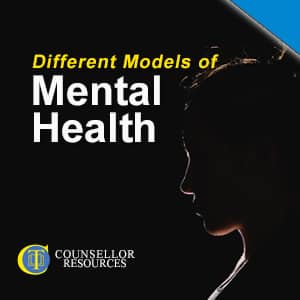Models of Mental Health
The World Health Organization defines ‘mental health’ as:
‘a state of well-being in which every individual realizes his or her own potential, can cope with the normal stresses of life, can work productively and fruitfully, and is able to make a contribution to her or his community.’
There are various different models of mental health.

a. Faith Model
Religion and spirituality are two different concepts.
Generally speaking, religion is a belief system based on moral values and an overseeing body. It is organised, and has a sociological element – that is, it affects the way our society functions (e.g. through widely celebrated events that appear in the calendar, such as Christmas, Easter, Ramadan, Eid and Diwali).
Spirituality, meanwhile, is considered more free-flowing and psychological. It is a private experience that promotes personal growth. This may take all kinds of forms, e.g. practising yoga or climbing a mountain.
Spirituality encourages people to ask the big questions about life and themselves.
Watch this Lecture + Access Hundreds of Hours of CPD
Certified CPD for Qualified Counsellors
- Hundreds of hours of on-demand CPD lectures to help you stay current with your CPD ethical requirements
- Support, and be supported, by thousands of other counsellors as a member of the exclusive online community.
- Access your learning anytime you want ... anywhere you choose ... using any device type — desktop or mobile.

The faith model assumes that mental distress is caused by factors such as:
- falling out of favour with God, feeling an abandonment by the higher power (which lies outside the individual, e.g. God)
- suffering being a condition of penance (e.g. Carl Rogers’ parents, who were Calvinists, believed that going to see a film or having a fizzy drink Coca Cola was sinful)
- sinning requiring repentance, so involving fearfulness
- having to follow a moral code in the form of commandments or scriptures that guide people on how to live their lives.
Counselling clients may wish to talk about their relationship with faith, and it’s important to tread carefully in case the theory we’re working to (e.g. person-centred) somehow clashes with the person’s faith.
For example, person-centred philosophy advocates that all humans are essentially good, whereas Christianity suggests that babies are born with original sin.
Faith can be a really solid structure that keeps the client afloat in times of difficulty. For example, research has shown that people with faith tend to have more resilience following traumatic situations than those who don’t.
Advantages of the faith model are that it:
- can link to people’s deepest values
- holds out hope and healing, especially with death and loss (e.g. that you can meet again in heaven)
- allows people to feel a connection to something bigger than themselves
- offers spiritual support from whichever higher power people believe in
- promises spiritual forgiveness, once sin is repented
- includes support from religious institutions and leaders (e.g. clergy, imams and rabbis)
- provides communal rituals to facilitate life transitions (e.g. christenings, bar/bat mitzvahs, weddings, marriages and funerals)
- reframes stressors into a benevolent system of meaning (e.g. the idea that the deity never puts on people’s plates more than they can handle), enhancing resilience
- involves the idea that people are being guided by a higher power.
Whether or not you share the client’s beliefs, it’s really important to honour them, working within this framework.
Faith can be a really solid structure that keeps the client afloat in times of difficulty.
Possible disadvantages are that faith:
- can be subjective in how it’s perceived (e.g. a client may genuinely believe that their deity is punishing them
- may be insufficient, not providing all the resilience that someone needs – other interventions may be needed
- could be part of the problem (e.g. if a client is in a faith community that is abusive).
Free Handout Download
Models of Mental Health
b. Medical Model
The medical model assumes that mental distress or illness is caused by physical factors such as:
- chemical imbalances or defects
- damage to the structure of the brain
- genetic factors.
Mental health difficulties are therefore divided into diagnoses (such as depression, schizophrenia, obsessive-compulsive disorder, bipolar disorder and anxiety), with treatment seen to lie in medically grounded procedures such as surgery, medication and electro-convulsive therapy.
Many clinicians these days do recognise, understand and use other models too.
Advantages of the medical model include that it:
- is evidence-based (in the UK, this means it is approved by the National Institute for Clinical Excellence)
- is readily available (often more so than talking therapies)
- acknowledges that some mental health conditions may be genetic (at least in making it more likely certain people will develop the condition, given a particular set of environmental factors).
The disadvantages of the medical model are that it:
- treats the symptoms, not the underlying issues
- pathologises natural mental and emotional distress (for example, in past times, the Diagnostic and Statistical Manual of Mental Disorders has included ‘Child Abandonment Complex – anxiety when parents split up – and even homosexuality as mental illnesses).
c. Social Model
This model was developed in the 1970s and 1980s, mainly because some members of the community of people with mental health difficulties felt this area was not well supported.
It focuses on the broader influences on health such as social, cultural and environmental issues.
So the idea of the social model is that our mental health is directly attributable to where we are in society: work, family, employment, money, etc.
It is a holistic community-based perspective that sees a link between mental well-being and social policy, making sure that people can access their own culture and not feel alienated.
Many charities adopt the social model, helping people to become stable, e.g. through education and through support for individuals, families and carers.
Factors that are seen to influence mental health in the social model include:
- socioeconomic, cultural and environmental conditions
- housing and living conditions
- nutrition
- education
- healthcare services
- facilities (e.g. water and sanitation)
- work and working conditions.
Mental well-being does not exist in isolation. Rather, it’s an amalgam of our subjective experience, the society we live in and our individual biology.
d. Psychological Model
This model includes the full range of therapies on offer, for example:
- psychoanalysis
- transactional analysis
- person-centred counselling
- cognitive behavioural therapy
- couples counselling
- art therapy
- eye movement desensitisation and reprocessing
- narrative therapy
- solution-focused therapy.
The psychological model assumes that mental distress is caused by factors such as:
- faulty thinking
- unresolved issues from childhood
- introjected values
Across all models, it is generally agreed that the therapist–client relationship is a key factor in bringing about positive change.
Advantages of the psychological model include that:
- it is evidence-based, working as well as antidepressants
- it also provides a unique space and relationship not found in other models of mental health.
The disadvantages are:
- some individuals may need more than one area of support
- talking therapies don’t work for everyone (for example, those who are not ready for it, are too fragile, are not well enough or believe the world needs to change rather than them). However, pre-therapy (developed by Garry Prouty) could be a helpful first stage for them.
- there is often a long wait for counselling that’s free at the point of delivery, and many people can’t afford to pay for private therapy.
e. Bio-social Model
The bio-social model is mixed, combining the other different models. It is within this model that our real-world work as therapists tends to lie, touching on all the other models in some respect.
Mental well-being does not exist in isolation. Rather, it’s an amalgam of our subjective experience, the society we live in and our individual biology.
Thus, it’s important as a therapist to consider and draw on all models as appropriate when working with clients.
Free Handout Download
Models of Mental Health